
Panama, officially the Republic of Panama, is a country in Latin America at the southern end of Central America, bordering South America. It is bordered by Costa Rica to the west, Colombia to the southeast, the Caribbean Sea to the north, and the Pacific Ocean to the south. Its capital and largest city is Panama City, whose metropolitan area is home to nearly half the country's over 4 million inhabitants.

The history of Panama includes the history of the Isthmus of Panama prior to European colonization.

José Eloy Alfaro Delgado often referred to as "The Old Warrior," was an Ecuadorian politician who served as the President of Ecuador from 1895 to 1901 and from 1906 to 1911. Eloy Alfaro emerged as the leader of the Liberal Party and became a driving force for fairness, justice and liberty. He became one of the strongest opponents of the pro-Catholic conservative President Gabriel García Moreno (1821–1875). The "Viejo Luchador" played a central role in the Liberal Revolution of 1895 and fought against conservatism for almost 30 years.
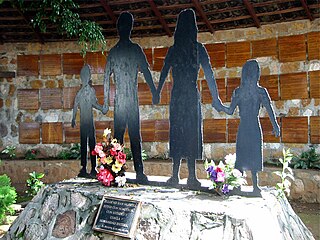
The El Mozote massacre took place both in and around the village of El Mozote, in the Morazán Department, El Salvador, on December 11 and 12, 1981, when the Salvadoran Army killed more than 811 civilians during the Salvadoran Civil War. The army had arrived in the village on the 10th, following clashes with guerrillas in the area. The Salvadoran Army's Atlácatl Battalion, under the orders of Domingo Monterrosa was responsible for the massacre.
Public holidays in Panama include:

Juan Pablo Duarte y Díez was a Dominican military leader, writer, activist, and nationalist politician who was the foremost of the founding fathers of the Dominican Republic and bears the title of Father of the Nation. As one of the most celebrated figures in Dominican history, Duarte is considered a folk hero and revolutionary visionary in the modern Dominican Republic, who along with military generals Ramón Matías Mella and Francisco del Rosario Sánchez, organized and promoted La Trinitaria, a secret society that eventually led to the Dominican revolt and independence from Haitian rule in 1844 and the start of the Dominican War of Independence.

The Dominican War of Independence was a war of independence that began when the Dominican Republic declared independence from the Republic of Haiti on February 27, 1844 and ended on January 24, 1856. Before the war, the island of Hispaniola had been united for 22 years when the newly independent nation, previously known as the Captaincy General of Santo Domingo, was unified with the Republic of Haiti in 1822. The criollo class within the country overthrew the Spanish crown in 1821 before unifying with Haiti a year later.
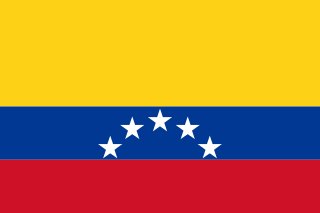
The Republic of Spanish Haiti, also called the Independent State of Spanish Haiti was the independent state that succeeded the Captaincy General of Santo Domingo after independence was declared on November 30, 1821 by José Núñez de Cáceres. The republic lasted only from December 1, 1821 to February 9, 1822 when it was invaded by the Republic of Haiti.
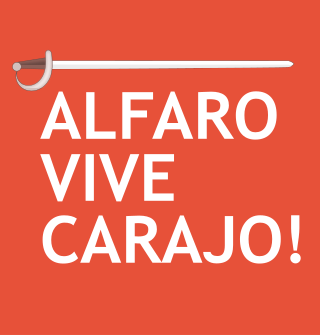
¡Alfaro Vive, Carajo! (AVC), another name for the Fuerzas Armadas Populares Eloy Alfaro, was a clandestine left-wing group in Ecuador, founded in 1982 and named after popular government leader and general Eloy Alfaro. The group was labeled as a terrorist organization by the Ecuadorian state during the period of the former president León Febres Cordero. It existed between 1983 and 1991, when it carried out various armed actions and criminal acts in Ecuador, with Colombian (M-19) and Nicaraguan influence. The group was initially formed sometime in the 1970s, but was not active militarily for the first few years of the 80's.

Policarpa Salavarrieta, also known as La Pola, Or phantom of Bogota was a Neogranadine seamstress who spied for the Revolutionary Forces during the Spanish Reconquista of the Viceroyalty of New Granada. She was captured by Spanish Royalists and ultimately executed for high treason. The Day of the Colombian Woman is commemorated on the anniversary of her death. She is now considered a heroine of the independence of Colombia.
The constitutional history of Colombia is the process of formation and evolution of the different constitutions that Colombia has had since its formation.

The Dominican Restoration War or the Dominican War of Restoration was a guerrilla war between 1863 and 1865 in the Dominican Republic between nationalists and Spain, the latter of which had recolonized the country 17 years after its independence. The war resulted in the restoration of Dominican sovereignty, the withdrawal of Spanish forces, the separation of the Captaincy General of Santo Domingo from Spain, and the establishment of a second republic in the Dominican Republic.

The Department of the Isthmus was one of the departments of the Republic of Gran Colombia. It was created in 1824 and named after the Isthmus of Panama. It covered the territory of what is now the country of Panama and some disputed coastal territories farther northward along the Caribbean shoreline of present-day Costa Rica and Nicaragua.

The Haitian occupation of Santo Domingo was the annexation and merger of then-independent Republic of Spanish Haiti into the Republic of Haiti, that lasted twenty-two years, from February 9, 1822, to February 27, 1844. The part of Hispaniola under Spanish administration was first ceded to France and merged with the French colony of Saint Domingue as a result of the Peace of Basel in 1795. However, with the outbreak of the Haitian Revolution the French lost the western part of the island, while remaining in control of the eastern part of the island until the Spanish recaptured Santo Domingo in 1809.

La Villa de los Santos also known La Heroica Villa de Los Santos, is the capital city and a corregimiento of the Los Santos District of Los Santos Province, Panama. It is at the left edge of La Villa River. Founded as Santa Cruz in 1555 by Juan Rodriguez Monjaraz, the then governor of the region, the city is known for First Cry of Independence and the population's efforts in the movement to separate Panama from Spanish power in November 1821.

Independence of Panama from Spain was accomplished through a bloodless revolt between 10 November 1821 and 28 November 1821. Seizing the opportunity, when the Spanish governor left Panama to march on rebellious Ecuadorians, José de Fábrega led a push for independence. Rebels in the small town of Villa de Los Santos made the first declaration for independence and the movement quickly spread to the capital. Fearing that Spain would retake the country, the rebels quickly joined the Republic of Gran Colombia.

The Declaration of Independence of Panama is the document through which Panama declared its independence from the Spanish Empire on November 28, 1821. It was proclaimed in the Cathedral Plaza of Panama City after a council of leaders had met and drafted twelve points calling for severing Panama's relationship with the Spanish Crown and joining with the newly formed Republic of Gran Colombia.
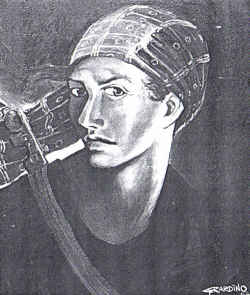
Juana Saltitopa, also known as "La Coronela", was a Dominican activist and member of the Dominican military. She played an important role in the Dominican War of Independence, specifically in the Battle on 30 March 1844 in Santiago de los Caballeros. Her exact birthdate is unknown as is her death.
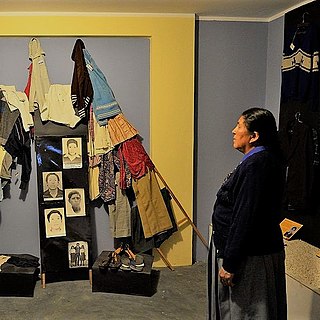
Angélica Mendoza de Ascarza was a Peruvian Quechua human rights activist. She is considered to be a symbol of human rights in Peru and of those who disappeared in the country from 1980 to 2000 as a result of the internal violence in Peru and has been recognized by the International Red Cross and Amnesty International as a "tireless advocate for those women who lost their loved ones."

The October 9 Revolution was a successful revolt against the Spanish Empire in Guayaquil on October 9, 1820. It was led by the General Antonio José de Sucre and directed by Simón Bolívar. The revolt established a revolutionary junta and created the Free Province of Guayaquil, an independent state. The independence of Guayaquil revived the war of independence of the Real Audiencia de Quito as part of the Spanish American wars of independence. Prominent events in the revolution include the uprising of the Spanish garrison in the city of Guayaquil and the control of the Pacific by the Liberating Expedition of Peru, under the command of José de San Martín.
















